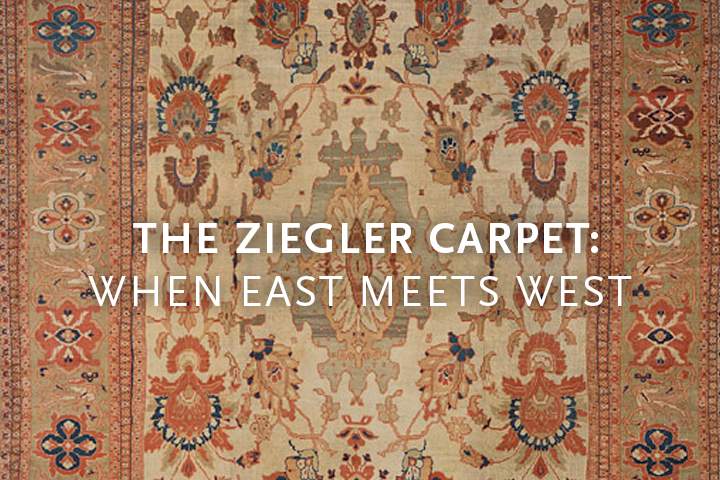August 01, 2018

FJ Hakimian Ziegler Sultanabad Carpet #06175.
For more than a century the name Ziegler has been a label of quality, synonymous with a highly decorative yet subtle Persian carpet. The types of harmonious, fluid patterns of scrolling vines and bold floral and plant forms associated with Zieglers exemplify the successful melding of Eastern designs and Western aesthetics. They have a timeless appeal that makes the Ziegler carpet extraordinarily adaptable to a wide variety of interiors, whether traditional or modern, simple or grand. Indeed, Ziegler carpets are a veritable decorator's dream, and they are even more fashionable today than when they first appeared over one hundred years ago. Then as now, Ziegler carpets served as tasteful backdrops to compliment and unify the aesthetic themes of distinctive rooms.
FJ Hakimian Ziegler Sultanabad #06209. Persia 1890, 11'1" x 11'0"
The history of Ziegler carpet production, like Ziegler carpets themselves, is a fascinating study in West meets East. The birthplace of the Ziegler carpet was Sultanabad in west-central Persia, where the Anglo-Swiss firm of Ziegler & Company organized carpet weaving for export in the late nineteenth century. Ziegler were commission agents for European manufacturers in the export and sale of piece goods in the Middle East, and their decision to invest in Persian carpet production in the 1870s was related to the fall in the international rates of exchange for Persian currency. It was also linked to a dramatic increase in European and American demand for Oriental carpets at that time - a market growth which itself was directly tied to the burgeoning prosperity of Western society following the Industrial Revolution.
FJ Hakimian Ziegler Sultanabad #06144. Persia 1880, 22'3" x 13'4".
The fashion for hand-crafted Oriental carpets can be seen as a consumer reaction to shoddy, mass-produced Western goods. This demand was influenced and popularized by museum exhibitions, world's fairs, the Arts and Crafts movements and the then newly established "Oriental" sections in carriage trade department stores like W.J. Sloane and B. Altman in New York, Liberty in London and Haas in Vienna, each of which emphasized the superior design and workmanship of Oriental carpets in comparison with Western machine-made fabrics. As a result, the Oriental carpet became an essential decorative element in elegant homes like the Guinness estate at Elveden Hall in England and the Deshon-Allyn House in New London, Connecticut.
FJ Hakimian Ziegler Sultanabad #06038. Persia 1870, originally commissioned by Anglo-Swiss firm Ziegler & Co, 23'5" x 14'5".
Zieglers catered to this trend by trading in both new and antique rugs like the magnificent sixteenth century Ardabil carpet now in London's Victoria and Albert Museum. It is therefore not surprising to find echoes of the traditional Persian design vocabulary, like arabesque and palmette borders, in the pieces woven by Ziegler for export.
Ziegler's stylized interpretations of classical Persian patterns were guided by designs provided by Altman, Sloans and other select Western retailers who were not only their biggest customers, but were also keenly attuned to a highly sophisticated consumer market. Ziegler carpet patterns, palettes and dimensions were thus carefully crafted to compliment Western furnishings styles, color preferences and room sizes. Comparable to the treatment of the Persian inspired elements in carpets created by William Morris, the sense of balance and scale in Ziegler's arrangement of flower and leaf motifs on frameworks of scrolling vines demonstrate just how well these carpets fit into the Western idea of interior. These customized designs were key to the success of Ziegler carpets, and they were so carefully guarded that the company even obtained copyright protection for them.
FJ Hakimian Ziegler Sultanabad #06099. Persia 1800, originally commissioned by Anglo-Swiss firm Ziegler & Co, 16'8" x 11'8".
To suit its international clientele, Ziegler also broadened the spectrum of jewel tones traditionally used as the predominant colors in Persian rugs, creating carpets with ground colors like apricot, wheat, beige, tobacco, soft blue and bronze. To ensure color quality, Ziegler employed European specialists to supervise the dyeing of wool in their Sultanabad compound. Carpets were woven in homes in the villages around Sultanabad. Prior to shipment abroad, finished carpets were carefully examined to confirm that they met Ziegler's high standards. Since Ziegler did not have their own sales outlet but instead produced for retailers, their carpets have neither logos nor trademarks. Indeed, none are necessary, since the colors, designs and quality of these weavings are so distinctive.
FJ Hakimian Ziegler Sultanabad Carpet #06175. Persia 1880, 20'5" x 15'0".
The production of Ziegler's quality controlled carpets, with their skillfully handled patterns and palettes, was time consuming and labor intensive but it resulted in a product that has withstood the test of time. Even today, with its now mellowed colors and lustrous wool, the Ziegler seems fresh and modern yet classic, the ideal decorative carpet to harmonize and enhance the art and antiques of important interiors.
View our Antique Sultanabad carpet collection here.

![06209-[11-1x11-0] 06209-[11-1x11-0]](https://www.fjhakimian.com/sites/fjhakimian/files/06209-%5B11-1x11-0%5D.jpg)
![06144-[22-3x13-4] 06144-[22-3x13-4]](https://www.fjhakimian.com/sites/fjhakimian/files/06144-%5B22-3x13-4%5D.jpg)
![06038-[23-5x14-5] 06038-[23-5x14-5]](https://www.fjhakimian.com/sites/fjhakimian/files/06038-%5B23-5x14-5%5D.jpg)
![06099-[16-8x11-8] 06099-[16-8x11-8]](https://www.fjhakimian.com/sites/fjhakimian/files/06099-%5B16-8x11-8%5D.jpg)
![06175-[20-5x15-0] 06175-[20-5x15-0]](https://www.fjhakimian.com/sites/fjhakimian/files/06175-%5B20-5x15-0%5D.jpg)